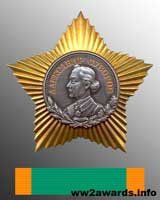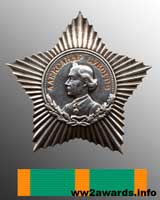Order of Suvorov
The Order of Suvorov is a Soviet military decoration that was reward senior army personnel for exceptional leadership in combat operations.

Dimensions 1st class - Diameter 56 mm. 2-3 class - 49 mm.
Materials 1st class: Platinum 29g. Gold 8,8 g. Silver 9.2 g. Weight 42g.
2nd class: Gold 23g. Silver 12.2g. Weight 29g.
3rd class: Silver 22.9 Weight 25.3g.
Artist Peter Skokan

Prices for Order of Suvorov
To date, prices for the Order of Suvorov start from:
Order of Suvorov 1 class:
1942-43 Type 1 ribbon bar ≈102 pcs. - 150000$
1943-91 Type 2 screw fastening ≈291 pcs. - 100000$
Order of Suvorov 2 class:
1942-43 Type 1 ribbon bar ≈203 pcs. - 60000$
1943-91 Type 2 screw fastening ≈2660 pcs. - 15000$
Order of Suvorov 3 class:
1942-43 Type 1 ribbon bar ≈912 pcs. - 15000$
1943-91 Type 2 screw fastening ≈3100 pcs. - 6000$
The price has been updated on: 02.10.2025 yr.
The award was established on July 26, 1942, the first awarded order of Suvorov became Georgy Zhukov, the second Alexander Vasilevsky, the third Nikolai Voronov, all were awarded on January 28, 1943 for preparation and implementation of offensive operations against Wehrmacht troops.
A total of 7267 awards were awarded to the Order of Alexander Suvorov, of which 391 were awarded the Order of the First Degree, 2863 second and 4012 third.
Order of Suvorov in the award system of the USSR
History Order of Suvorov

The Order of Suvorov became the first order in history of Soviet Union, which had three degrees, and took the highest step among orders, which awarded command of the Red Army. Simultaneously with it on June 29, 1942 two other, the younger order of Kutuzov and Alexander Nevsky were established.
The Order 1st class was awarded to army commanders for exceptional leadership of combat operations. The Order 2nd class was awarded to corps, division, and brigade commanders for a decisive victory over a numerically superior enemy. The Order 3rd class was awarded to regimental commanders, their chiefs of staff, and battalion and company commanders for outstanding leadership leading to a combat victory. Despite its official award criteria, both the first and second classes of the Order were sometimes awarded to defense industry executives, as well as to designers of various weapons and military equipment.
The Order of Suvorov is a five-pointed star in the form of diverging rays, in the center is a circle with the image of Alexander Suvorov, lower part of circle is framed by a wreath of laurel and oak leaves, along the upper part of circle there is inscription «АЛЕКСАНДР СУВОРОВ» (ALEXANDER SUVOROV). The Order of the first class also distinguished presence of a red star on upper ray of star of the Order and a larger size. Material for production of the Order of Suvorov I class was chosen platinum, 2 - gold, 3 class was made of silver.
Alexander Vasilyevich Suvorov 13 November 1729 or 1730 – 6 May 1800 was a Russian military leader, considered a national hero. He was the Count of Rymnik, Count of the Holy Roman Empire, Prince of Italy, and the last Generalissimo of the Russian Empire. Becoming the General of the Infantry in 1786, he commanded in the Russo–Turkish War of 1787–1792 and won crushing victories at the Battle of Rymnik and Siege of Izmail. For his accomplishments, he was made a Count of both the Russian Empire and Holy Roman Empire. Suvorov put down a Polish uprising in 1794, defeating them at the Battle of Maciejowice and storming Warsaw. As commander of the Austro-Russian army, captured Milan, and drove the French out of Italy at the Battles of Cassano d'Adda, Trebbia, and Novi. Suvorov was made a Prince of Italy for his deeds. Suvorov is considered one of the greatest commanders in Russian history. He was awarded numerous medals, titles, and honors by Russia, as well as by other countries. Suvorov secured Russia's expanded borders, renewed military prestige, and left a legacy of theories on warfare.
Updated: 2025-10-02 03:06:53